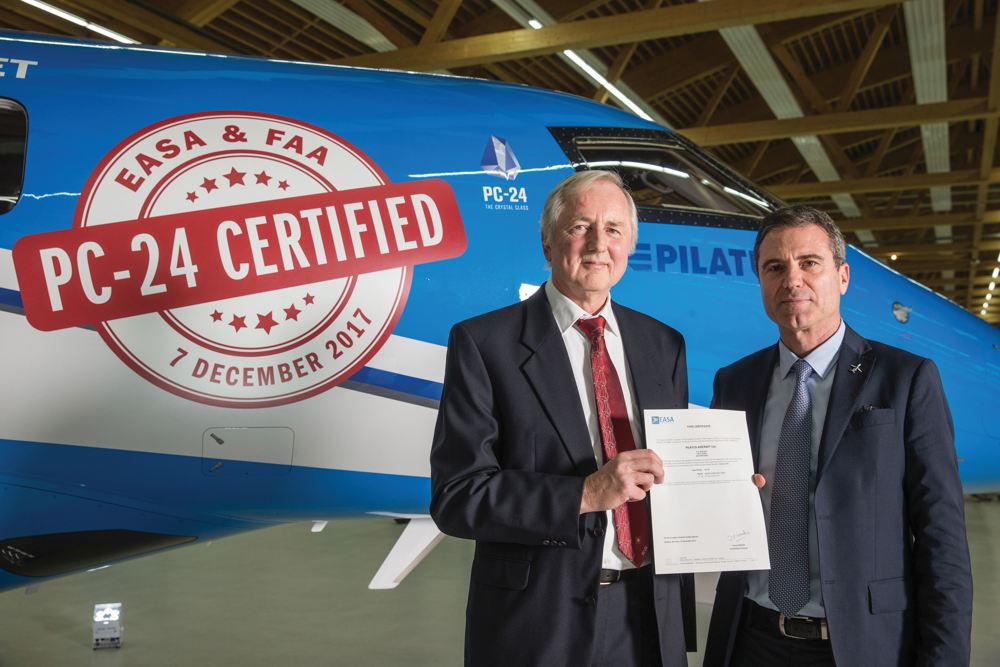Building a super versatile jet!

Pilatus’ team of engineers were tasked with the development of the twin-engine PC-24. Based in the Alpine town of Stans, Switzerland, Aerospace Manufacturing hears how the team used Siemens’ simulation models to deal with the complexity of designing such an aircraft.
In 2010, the Pilatus PC-24 began as an idea on paper. In February 2018, the first PC-24 was certified by the European Aviation Safety Agency (EASA) and Federal Aviation Administration (FAA) and delivered on time to the first customer, PlaneSense.
There are a lot of things that make the PC-24 unique, but how do you make something like this? The first thing you hear when you talk to Nicola Buonomo and Alessandro Scotti is how passionate they are about the PC-24, a jet the two engineers have been working on the past eight years.
“When we started to develop the PC-24, we tried to bring the flexibility of the PC12 into the PC-24 design,” Buonomo begins. “We knew our customers wanted to have a plane that could fly faster and longer while keeping the same Pilatus PC-12 characteristics. One idea was that our customers could load a motorbike in the back of the plane. Obviously, doing all this was a challenge.”
Buonomo and Scotti and their team started with the concept design phase, then moved to preliminary design and, finally, a refined design. At the beginning, the team just used legacy tools to get a rough starting point for the computational data.
“We started with a blank piece of paper and thought about the wings. Where do we put them: high or low? Where do we put the horizontal tail? Should it be high or low? What about the engines?” asks Buonomo.
“The more we progressed with the conceptual phase, the more we understood the limits,” says Scotti. “Then we started looking at other tools. Nicola and I have different backgrounds, so he was already looking at the Simcenter portfolio and I had experience with similar LMS testing tools at my former job. We were definitely going in the same direction.”

They started to think about how to integrate tools like Simcenter 3D (formerly LMS Virtual.Lab software) and LMS Test.Lab software early in the process. Working in loads, they knew they had to think ahead to when the concept would be finalised and the real work would begin.
“We knew that there would be a learning curve. We started using LMS Test.Lab because we knew it was a valuable tool as well as Simcenter 3D to look at our ground vibration test (GVT) process. We started exploring these tools way before we even had to do a test because we had to think ahead. Otherwise, we would be late with the data. Since we are at the beginning of the chain, we would slow down the entire PC-24 process,” adds Buonomo.
The team integrated the Simcenter tools in parallel with the PC-24 development process. When they started they were still using methods used during the PC-12 development, but the team knew they would have to do things differently this time.
“The PC-24 was a challenge. Technically speaking, we were going from a turboprop to twin jet engines. This speed range was a big jump for Pilatus. We were exploring areas where we had never been before,” says Buonomo. “We needed to find the right tools so that we could achieve our goal, which was basically to provide the right load data and analysis results to the other internal teams. The other teams are always complaining that we load engineers are always late. Being a loads engineer, you constantly have a target on your back.”
Adds Scotti: “The sooner you can get the right data on a test, the more confident everyone in the development process is. This can be the easiest and most difficult of tasks. You can’t forget about the test pilots either. They are the ones that have to fly the prototype to the limits on the flight envelope and they do ask questions about flutter and wing movements and loads during test flights. With LMS Test.Lab, we could show them the mode shapes. This gives them the confidence in the plane to continue to push the limits and fly to the edge.”
Moving toward a digital twin
The team wanted the best possible solution for the PC-24 using the Simcenter tools. They started using LMS Test.Lab to handle all the testing they would have to do on the PC-24, a new design for Pilatus. This was especially important because they would need to be compliant with the various certification agencies to get the plane in the sky commercially.
“Getting LMS Test.Lab into the process at the beginning was our main goal, but then we added Simcenter 3D into the picture. This step really improves the quality of the finite element model using the GVT testing data and correlation. So, we started to count on Simcenter 3D as well to update our models and optimise them so that they reflected reality,” explains Scotti.
Creating an accurate digital twin is tricky, but when engineers know they have an accurate simulation, showing compliancy becomes much easier. Engineers can prove what they are measuring is well correlated to what was originally calculated numerically in the beginning of the process.
“The final result has to be a digital twin according to the certification agencies. It has to reflect reality. From an engineering point of view, we tend to talk about correlation. It all does work together. You use the test data to test the physical aircraft, but you also use it to improve your finite element models. I guess you could say that it is a joint venture between physical reality and the digital world,” adds Buonomo.
Certification success

One of the concerns that you hear in the hallways of some aircraft manufacturers today is certification issues. But not at Pilatus. The company successfully obtained both EASA and FAA certification in December 2017. It was the first European company to apply successfully for a light jet in the AMC-S20 certification area.
“EASA put a lot of pressure on us in terms of requirements. Whether we liked it or not, we had to improve the way we worked. In terms of testing, they wanted to know what we were doing and why. This is when we could really use our Simcenter tools to present the GVT and flutter test results. With GVT testing, we could show that we had good correlation with our models and our test data. With the flutter test, we could show how it was going and what modes were changing,” explains Scotti. “Those two Simcenter tools, Simcenter 3D and LMS Test.Lab, really helped us build confidence in our certification case. It was a very positive experience,” adds Buonomo.
Tackling tough deadlines
Since the PC-24 was a clean sheet project, the team knew they needed to learn a lot from the first GVT and its results. Using these two Simcenter tools provided a shortcut to speeding up the process and improving structural knowledge, the models and the prototype. Like most GVT campaigns, the team spent two weeks testing 24/7 along with the GVT experts from Simcenter Engineering. Thanks to Simcenter Engineering's own LMS SCADAS hardware system with 256 channels, the team could get to the data they needed by just adding an accelerometer or two.
“We changed a few things during the design so we had to test for that during the GVT as well. Luckily, with the Simcenter tools and the team we had from Simcenter Engineering, we could explore exactly what we needed during the testing phase,” says Buonomo.
Scotti concludes: “By adding Simcenter 3D to the picture, we could see that we were going in the right direction. A key point of success for our GVT was that we were using the same software as the Simcenter team. Since we all were using LMS Test.Lab and Simcenter 3D, we could read the data right onsite. It was a main reason that our testing campaign went so quickly and in the right direction.
“The flexibility of the Simcenter Engineering team and their quick response was really one of the key success points of getting this GVT done on time while proving that our solutions were working as well. Everyone at Pilatus really appreciated the help from the Simcenter Engineering team. The flexibility and know-how from the Simcenter team helped us stick to really tight deadlines.”












